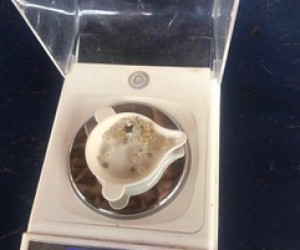The iDredgeTM commissioned by Africa Resources and designed and fabricated by proudly South African company Imilingo Mineral Processing has produced a whopping 14,1 carats from 1200kg of alluvial/gravel deposits in the Kasai River of the DRC in the first test run.
Over many years, traditional river-based alluvial diamond mining has seen divers scouring the riverbed with heavy suction pipes coupled to centrifugal pumps. Thomas Häggkvist, the CEO of Africa Resources AB, approached Imilingo Mineral Processing in October 2016 for a possible solution to the cumbersome and hazardous diving conditions involved in alluvial diamond recovery. “Modern mining techniques and sorting technology has been severely lacking in alluvial diamond mining and the iDredgeTM has certainly delivered in injecting some much needed technological advancement in the industry,” commented Häggkvist.
Jaco Prinsloo, MD of Imilingo, who has extensive knowledge of diamond processing through his experience when working as the lead engineer for DRA on several large diamond mining projects, worked with an innovative team of engineers to design and fabricate the iDredgeTM. Prinsloo asserts the ingenuity of their design is transforming digital automation in the diamond mining game, “The vessel consists of a floating platform connected to two pontoons. A Dragflow 60Kw submersible pump with high-depth compensators provides suction and allows particles up to 60mm in size to be pumped through the 150 NB pipe. An onboard rotatable crane submerges the pump and is there to make the pump accessible for maintenance purposes. A 150KVA diesel generator supplies power for the iDredgeTM and the mined material is fed onto a double-deck vibrating screen. Both generator and screen remain on the riverbank.” He added that “The iDredgeTM has the unique advantage of being collapsible for transport, making it exceptionally feasible to reach remote destinations.”
The iDredgeTM began the long journey from Imilingo’s Centurion fabrication facility in December 2017. Road transport to the port at Durban took a week and after 17 days at sea, the two 40ft and two 20ft containers arrived at the port of Matadi on the West Coast of the DRC. The contents of the 40ft containers were unloaded in the port and loaded onto trucks while the 20ft containers were loaded onto the trucks as-is. From there the trucks hauled the modular components to Kinshasa and onwards to the Kasai River.
“Much of the infrastructure in the DRC, especially the road network, is extremely eroded and this necessitated a change in the site where the iDredgeTM would be used,” Prinsloo said. “Originally the machine was destined for the Tshikapa river, but this had to be changed to the Kasai as the latter is more accessible for the large interlinked trucks and their precious cargo.”
A technical team from Imilingo Mineral Processing accompanied the mining team on their journey to help assemble the iDredgeTM. The machine was assembled in an excavation made by an excavator, next to the river and the same excavator did duty as a crane for some of the heavier components. When assembled, the excavation was flooded and the iDredgeTM entered the river. Cables were linked to the opposite shore to winch the vessel into position in the centre of the river. “Rivers in the DRC flow very fast and we had made sure that two very sturdy trees on either side of the river acted as anchors for the iDredgeTM cables,” Prinsloo explained. “Our client also requested that two outboard motors be fitted on the back of the iDredgeTM as an extra precaution to counter the initial measurement of around 1,7 meters per second for the flow of the river.”
Local villagers keen for employment and training assembled the 150 mm pipes using wooden dugout canoes to attach the HDPE floaters to support the pipes in carrying the dredged material to the shore. “Once the pump was started, it effectively pumped sand to reach the river-bottom bedrock. The dredged sand was sized on a vibrating screen and the material was then sifted by hand in what the local people term a ‘tammy’ that is French for sieve,” said Prinsloo.
After the Imilingo commissioning team left, the local site team continued operations and cleared the river bed of sand overburden before reaching the diamond gravel. The first diamond gravel was pumped on the 29th August 2018 and then washed by “tammy” to recover the company’s first diamonds.
The test run shows great potential for Africa Resources’ operations in Tshikapa and all parties are immensely optimistic at the prospect of diamond recovery in the area. “The test run showed bags of promise with 14,1 carats from 1200kg which would equate to 1175 cpht based on the isolated test. We are really excited about the yield this project could potentially generate and know the extensive efforts to unlock the mineral wealth will definitely pay off,” concluded Häggkvist.







